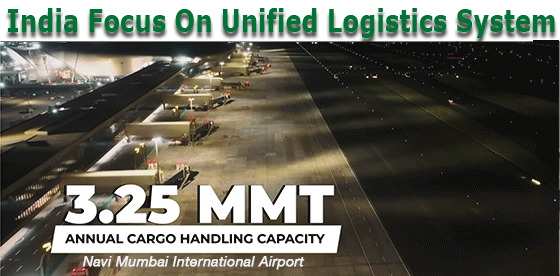 |
A dramatic change has been noticed in India's air cargo sector. The sector, once characterized with a fragmented network of airports, ports, and roads, is rapidly changing to a unified logistics system that is digitally advanced, globally competitive, and export-oriented. India is getting ready for a big launch in the global logistics field with its modern airports and improved customs operations.
Two new airports, the Navi Mumbai International Airport (NMIA) in the west and Noida International Airport (NIA) in Jewar in the north, are the main factors behind this change.
Navi Mumbai International Airport, which was recently inaugurated, is not merely an airport: it stands for a definite goal. Its unique situation offers exporters direct multimodal access from the industrial sector of Mumbai to the country's busiest port. With its tailored cargo facilities and speedy clearance, it intends to solve the traffic problem of the existing Mumbai airport and be the important part of the logistics system of India’s west coast.
 Farther in the north, NIA is expected to start operations in late November. CEO Christoph Schnellmann told reporters that Noida International Airport will begin with a “limited window of daytime operations” in the first few weeks gradually increasing to night flights. International flights are planned for the first half of 2026. Farther in the north, NIA is expected to start operations in late November. CEO Christoph Schnellmann told reporters that Noida International Airport will begin with a “limited window of daytime operations” in the first few weeks gradually increasing to night flights. International flights are planned for the first half of 2026.
NIA has been planned with a cargo focus from scratch and is connected to major expressways and industrial corridors. It is anticipated that when the airport is fully operational, it will be capable of managing one million tonnes of air freight annually, thus, providing new export possibilities to the region of Uttar Pradesh, Haryana, and the National Capital Region of Delhi.
Logistics in India is not just better because of the new airports. The combined effect of projects such as the Dwarka Expressway and Urban Extension Road-II, along with more than 100 multimodal logistics parks, is the creation of a network that interlinks highways, ports, and airports. The completion of Dedicated Freight Corridors (DFCs) is significant: transit time for long distances has gone down by up to 40% and manufacturers can deliver goods to air cargo terminals in a more efficient manner. Result: industries of electronics, pharmaceuticals, perishables, and textiles are becoming more dependable, their exports are getting faster and more cost-effective.
Impact on the ground is being complemented by the improvements taking place in the air cargo structure. The Central Board of Indirect Taxes and Customs (CBIC) has reduced red tape in numerous ways. It has done away with transshipment permit fees, simplifying rules for Unit Load Devices (ULDs), and creating an All-India National Transshipment Bond which is a uniform bond for easy movement of goods.
The main aspect of this change is digitization. ICEGATE is one of such tools which provide total visibility into customs operations. Now, exporters can do the paperwork, monitor the shipments, and get the approvals online. All these processes require less time and leave far less room for uncertainties.
One of the most significant trends is the improvement in cost efficiency. According to the National Council of Applied Economic Research/Department for Promotion of Industry and Internal Trade (NCAER/DPIIT) assessments, the share of logistics expenses in GDP has come down from roughly 14-16% to 7.97% - this is a positive move towards the government's target of halving the logistics cost to below 10%.
The impact of the reforms can already be seen. International air freight from India in 2024 increased by 19%, way ahead of the global average. The airports in Mumbai and Bengaluru have played a pivotal role in this expansion, especially in the exports of pharmaceuticals and perishable goods.
Comparing April to August 2025 with the same period of the previous year, total exports have gone up by 5.19%, with the growth of electronics, agriculture, and textiles being the main contributors: Agri-exports touched the $3.39 billion mark; the export of electronics has more than quadrupled; and apparel exports increased by 13% in December 2024.
The strength of India's competitiveness is in combining scale with strategy: low labor costs, a huge domestic market, and an advantageous geographical position at the junction of Asia, Africa, and the Middle East. Add to that, production-linked incentives (PLIs) and the global “China+1” trend make it increasingly difficult for India’s logistics-sector rivals in the Asia-Pacific region to keep pace with India.
As the country gears to reach $1 trillion worth of exports in FY26, the takeaway is straightforward: the story of the rise of air cargo in India is not a vision for the distant future - it is happening today with great determination, innovation, and smooth connectivity
Tirthankar Ghosh
|




 Vol. 24 No. 42
Vol. 24 No. 42 Vol. 24 No. 43
Vol. 24 No. 43 Vol. 24 No. 44
Vol. 24 No. 44